I’ve spent countless hours lately trying to figure out the best way to border a yard when you have a robotic mower. Here, I would like to show you which materials are best suited as a yard border for robotic mowers.
Which lawn border is most suitable for robotic mowers? The working area of mowing robots is best limited by ground level lawn edge stones. This enables the mowing robot to drive a little over the edge of the lawn and thus mow right up to the edge. This means that it is no longer necessary to trim the edges of your lawn yourself.
However, the range of possibilities for bordering your lawn is almost infinite, and you don’t necessarily have to use lawn edging stones. Boundaries made of concrete slabs, paving stones, granite stones or even bark mulch are also possible. You should also remember to choose the right width for your lawn border if you want the mowing robot to mow right up to the edge.
Contents
Which lawn edgings are useful for robotic mowers?
If your yard has not been specially prepared for the operation of a robotic mower, your robotic mower will tend to leave some grass on the outer edge, which you then have to laboriously trim by hand. At best, a lawn trimmer is used here to make the work at least a little easier.
In one of my recent articles I explain exactly how much grass is left untrimmed by the robotic lawn mower at the edge of your lawn and why this is so.
The ideal situation, however, is when your lawn is specifically designed so that the robotic mower cuts everything by itself, even the edges, so you won’t have to trim them by hand. To achieve this, the border should be as level as possible with the lawn. This allows the mowing robot to drive over the lawn border and mow right up to the edge.
One way to do this is to lay a border of lawn edging stones level with your lawn. These are also called mowing edge stones. This method is also used by gardening professionals and landscape architects to design yards for optimal operation of a mowing robot.
The following graphic illustrates once again how this design enables the robotic mower to mow right up to the edge. The boundary wire is laid about 2 inches from the lawn edge stones. As the robot drives up to 10 inches beyond the cable, it can mow the section between the boundary wire and the lawn edge stones with its comparatively narrow mowing unit.

If you use lawn edging stones, you must select the correct width
Depending on what kind of robotic mower model you choose for your yard, the appropriate level lawn edge stone will vary slightly in width. However, the size of the border between the edge stone and the lawn, which is behind the mowing edge stone, is even more important with regard to the width of the mowing edge stone.
It makes a difference whether you have a wall, a pool or a flowerbed leading up to your edging stones. If the robot still has some space once it crosses over the lawn edge stone, you can choose a slightly narrower edge stone. If there is, say, a wall or a pool beyond your edge stones, a wider lawn edge stone is necessary so that the lawn robot does not hit the wall or go into the pool.
I won’t go into too much detail at this point, as I have already written an extensive article about how wide the lawn edge stones should be.
But I will say this much: In places where the robotic mower still has some room to maneuver behind the lawn edge stone, edge stones with a width of 4 inches are often used. In other places it should be at least 8 inches, often even a little more.
You might need to install additional rising boundary stones in some places
Some places in your garden will need extra boundaries in place next to the boundary wire to prevent the mowing robot from crossing the boundary. Normally, the robot should only go beyond the boundary wire by 12 inches, but you can never rule out the possibility that a glitch will occur and the robot will go further than it should.
In places that have a slope, it is not uncommon for the mowing robot to gather too much momentum when driving downhill, causing it to rush past the cable before it has time to stop. If there is a pool on the other side, or a busy road, this might not end up so well for your robot.
Protruding boundary stones of approx. 6 inches ensure that the robotic mower will not pass over the corresponding area under any circumstances.
In the following locations, you should at least consider installing additional boundaries by means of projecting boundary stones:
- Along open waters (pool, pond, river)
- In places with slopes or cliffs
- Along a public road
Which lawn edge stones are available?
After you have determined what width your lawn edging stones should be, you can now begin to select suitable stones for your yard. Of course, you should not only pay attention to how wide the stones should be. You should also look at how well the stones complement your yard. There are many different sizes, shapes and colors to choose from.There are also other alternatives to lawn edge stones, which we will look at a bit later.
- “Swallowtail” Stones – These stones are called so because their end is shaped like the tail of a swallow. This makes it possible to build curves with them. They are usually 4 inches wide, although there are also wider variants. They are probably the most common lawn edge stones used for robotic mowers.
- 3/4-Granite Stones – These nearly-square stones are called so because they are rather roughly hewn and their side length can vary between 3-4 inches. These types of stones allow you much more flexibility in the shape in which you can make your border.
- Pavement concrete slabs – If you like to keep things simple and need something wide as a boundary for your house wall or similar, these 12 inch wide slabs are ideal. I have seen many owners of robotic mowers use such slabs.
- Rectangular paving – You can use these pavers to build really larger boundaries with wide curves. The stones are usually 8 x 4 x 2 inches in size. It is recommended to slurry the stones so that no weeds grow between the cracks.
- “Round” lawn edge stones – Another variation of the “swallowtail” stones that make it look as if you have simply laid a row of cylindrically shaped stones.
You can also border your lawn like this
Not everyone likes the look of lawn edge stones. Fortunately, there are alternatives that work just as well.
Bark mulch
You can remove the turf around your lawn and dig a trench, just as you would when laying lawn edge stones. However, instead of using lawn edging stones here, you line the trench with a foil. This prevents plants from growing into the trench. Then, you fill the trench with bark mulch.
However, bark mulch has some disadvantages: firstly, it leaches nitrogen from the soil during its decomposition, which makes more frequent fertilization necessary, though this is somewhat weakened by the foil barrier. Secondly, it decomposes over time and at some point must be replaced.
Lava grit
Here you can proceed in the same way as with the bark mulch: remove grass, dig a ditch and line it with foil. Fill the trench with lava grit. In contrast to bark mulch, this does not decompose, and it stores both moisture and valuable minerals.
But lava split also has a disadvantage: it increases the soil acidity. So if your plants prefer a low soil acidity, you should not opt to use lava grit.
Robotic mowers with edge mode can use narrower lawn edge stones
The robotic mowers of some manufacturers have a so-called edge mode (also called edge mowing, edge mowing function, or cut to edge). These include many models from ROBOMOW, and WORX.
When edge mode is used, the robot will, at regular intervals, e.g. every second day before each mowing operation, drive once along the outside of the boundary wire and mow the edge. Usually the mowing unit is offset towards the outside (i.e. to the right) so that they come closer to the edge. You can read more about the edge mode here and here.
These robotic mowers only need either narrow lawn edge stones, or sometimes no edge stones at all, depending on the edge of your lawn. With walls, fences, or any other solid obstacle they leave a very narrow strip, because they can’t reach the edge of the lawn.
However, along level boundaries, if you lay the boundary wire close enough to the edge, they can extend a few inches beyond the edge of the lawn when mowing and really mow the entire lawn to the edge.
By the way, here you can find a current overview of all current mowing robots with edge mode, which I would recommend.
Related questions
What should the distance be between level lawn edge stones and the boundary wire? The ideal distance varies from model to model. If the robotic mower has enough space to drive to the edge, the distance should usually be between 2 and 4 inches. It is best to test with your robotic mower first how far from the edge you should lay the cable before burying it.
How much grass is left on the edge of my lawn when using a robotic mower? This depends on the model and the nature of the lawn edge. If, as described here, you have done it in such a way that your lawn is bordered by level lawn edge stones, no grass should remain on the edge at all. Otherwise, in the worst case, up to 7 inches of grass may remain, which you will have to trim by hand. Read my article on this subject: How much grass robotic mowers leave on the edge of your lawn.





